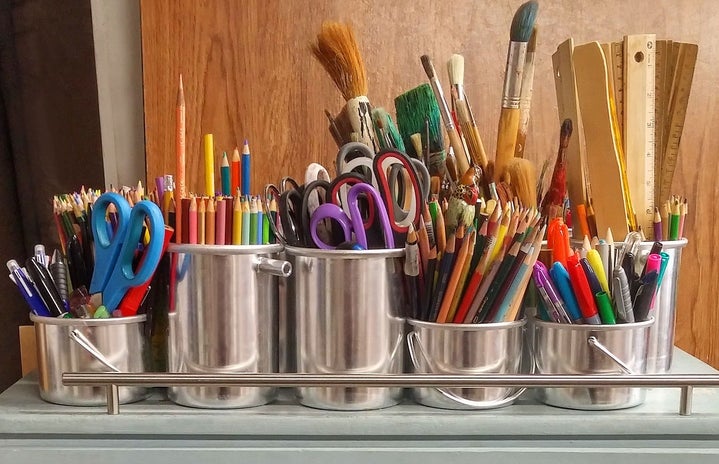Following your passions and forging a successful career path ideally go hand-in-hand. If you have a profitable skill or talent that yields many options for internships and jobs post-grad, you’re one of the lucky ones. There will likely never be a shortage of, say, finance, IT and medical professions looking for recruits, but what if you’re on the other side of the spectrum?
If your days completing your degree consisted of drawing, dancing and singing, where do you go next? Many skeptics in the world think degrees in the arts are next to useless, more “hobby” than “career,” but according to a study by the U.S. Census Bureau, 2.1 million working adults held primary jobs as artists in 2013.
Related: It’s Fine To Be A Fine Arts Major
If your first love is being on stage, you may be inclined to stick to your guns and go to audition after audition after graduation, hoping to land that one role that will jumpstart your Broadway run. In order to retain something more stable, however, you could look into who else keeps shows up and running. Theater majors are not only found in the spotlight.
Or maybe you’re into drawing—you have notebooks filled with sketches and rocked all your PowerPoint presentations during school. Your choices are far from limited to illustrating children’s books.
Professor Lydia Martin of Suffolk University in Boston, who received a BA in painting and drawing with a minor in art history, has seen many of her students in different areas of art go on to find success.
“[You can] become freelance fine artists, graphic designers, interior designers,” she says. “[You] also can apply to various fields in art administration, such as gallery director or assistant or museum director or assistant,” she says. “It is recommended to learn many various techniques and methods where there is the possibility in many job offerings and opportunities. Best not to be schooled in one technique; better to know many methods and materials within the art and design fields.”
People are making a living in the arts – in fact, according to the Bureau of Labor Statistics, average salaries for art and design careers were about $44,410 in May 2016, which was higher than all occupations by about $7,000 annually. So what are some of your options?
1. Take on art direction at a company that specializes in what you love
Miranda Soukup, a graduate of Winona State University and current art director at FRWD, an ad agency in Minneapolis, knew very early on in her college career that her goal was to become an art director and took the necessary steps to see it through. She says that her BA in mass communications with a focus in graphic design and studio art not only gave her the opportunity to stretch her creative muscles, but was also indispensable in giving her the tools to excel at her job.
“I absolutely love that I spent my years in college refining and building a visual and conceptual eye, and I’m able to push our clients and internal teams to do our very best work, both from a strategic and creative standpoint,” she says.
While it may seem that becoming an art director is very specific career choice, one that requires planning ahead and studying for this exact path, the options of places that hire for this position are endless.
Martin lists a number of areas of the art world where art directors are not only needed, but valued: graphic design or advertising agencies, interior design and architectural firms, journals or publishing companies, theater or film industries or even banking and financial firms.
With such a range of opportunities, even if art direction isn’t at the top of your list, it’s a viable option.
2. Work in marketing or communications for a venue you’re passionate about
Most post-grads who are walking away with arts degrees are well versed in the kind of background work that goes into keeping their industries alive. Companies typically require some kind of creative eye for public interest purposes; marketing, advertising and brand management are attractive careers for art and design graduates.
Laura Fagan, who graduated from the University of Kansas with a BA in theater, BS in strategic communications, and MS in digital content strategy, thrives in a theater environment but wasn’t looking to necessarily be on stage.
“I actually added the theater [major] last, because I did love theater and wanted a second degree,” says Laura, who has been working as a communications coordinator for Hennepin Theatre Trust in Minneapolis since 2016. “This has turned into exactly what I wanted: to be in a theater environment doing marketing and communications.”
Marketing is a fairly flexible career, making it a good way for arts grads to find their niche and run with it. Museums, publishing houses, rec centers, galleries and more need someone behind the scenes making their company shine.
Miranda, who was recognized as a 32 Under 32 recipient of top marketing professionals to watch in Minneapolis, likewise puts her own design techniques to work for branding purposes in fashioning websites, billboards and other collateral for the companies her firm manages.
3. Become a publicist or an agent for your area of interest
Creative souls need direction—that’s where publicists and agents come in. Whatever your industry of choice, if you know the ins and outs of the trade, you can succeed in publicity with the right training.
Fine artists, for example, could use a publicist to promote their pieces of art, whether that’s selling it directly or looking into galleries that would be willing to show their work. By forging relationships and connections with media, dealers and curators, their responsibility is to showcase the art of their clients in attractive, money-making ways. Being a fine artist yourself and having an expansive knowledge of the trade could be a straight line to success.
Likewise, those with degrees in film or theater could work as agents for performers, working out contracts and keeping a sharp eye out for the next big project. Being in-the-know in your respective field would be an incredible asset, as industry experience is what would enable you to create an agreeable career path for your client.
4. Consider teaching your subject of choice
This one may be the most counterintuitive of all, but if you find joy in seeing others perfect a craft, it could be worth seeking a teaching certificate and finding a school program that suits you. Knowing your trade well enough to help others learn is a sure-fire way to continue practicing your art while forging a path for yourself, even if it isn’t your first instinct.
Martin, for example, has been a foundation art professor for almost three decades, but did not originally intend to become an instructor. “I only planned to be an artist or painter and was willing to work at any job to support my painting time,” she says.
Martin found that teaching gave her the ability to practice her art while receiving a steady salary, which can be the ultimate benefit of pursuing a teaching position at any level. Laura says that she has also seen people in theater become successful in teaching. “Quite a few of my colleagues also have general theater degrees, but work in education,” she says.
Ultimately, teaching can be a fine way to stay savvy in your particular industry and continue to create amazing work. “My students and my colleagues have taught me so much and have helped me within my painting to gain concepts [and] understanding the creative process, and simply taught me about human nature and its desire to learn,” Martin says.
At the end of the day, an arts degree isn’t a road block. Whether you’re able to perform and create or pursue your passion in a different way, those with talent are crucial to the professional world.
“The world needs bigger, brighter, and contagious creative thinking, always,” Miranda says.


